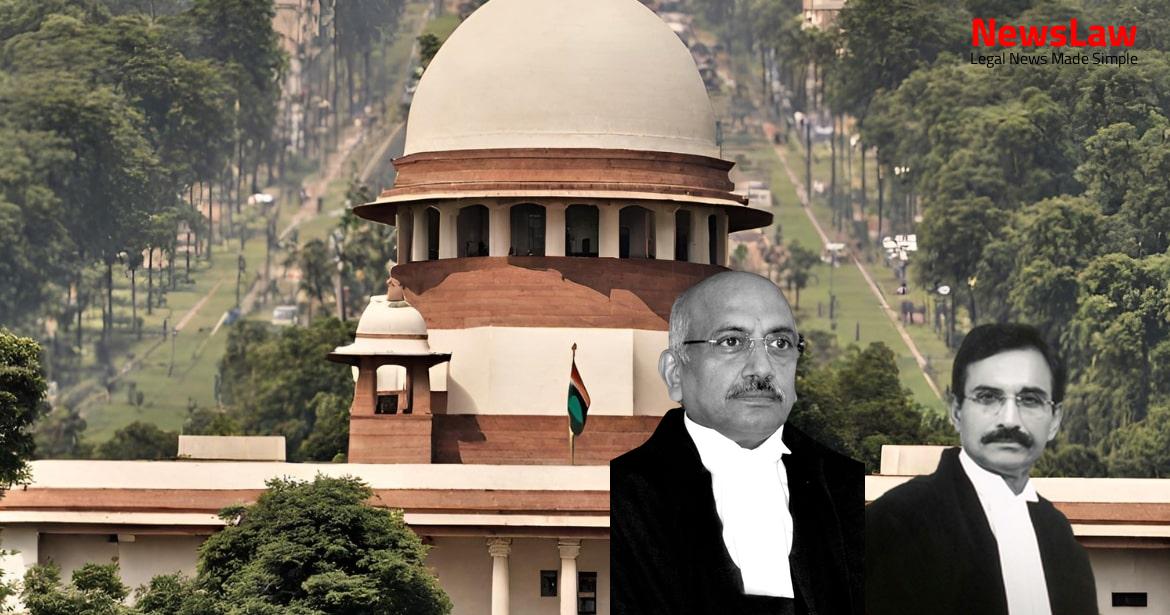Appellant – DBS Bank Limited Singapore had extended financial debt of around USD 50,000,000 (fifty million dollars only) or Rs. On 15.12.2017, Corporate Insolvency Resolution Process was initiated against the Corporate Debtor under the provisions of the Code. 8398,00,00,000
Also Read: https://newslaw.in/?p=680
(rupees eight thousand three hundred ninety eight crore only), representing approximately 49.22% of the total admitted claims of the financial creditors.
By the same order dated 24.07.2019, the NCLT dismissed the appellant’s application challenging the distribution mechanism of the resolution plan proceeds. Amended Section 30(2)(b)(ii) of the Code provides that operational and dissenting financial creditors shall not be paid an amount lesser than the amount to be paid to creditors in the event of liquidation of the Corporate Debtor under Section 53(1) of the Code. The two appeals preferred by the appellant against the orders/judgments of the NCLT dated 24.07.2019 and dated 04.09.2019 were taken up for hearing by the NCLAT. 99,74,00,000 (rupees ninety nine crore seventy four lakh only), being the difference between the amount which the appellant would have received in terms of the amendments noticed above and the amount received by the appellant on pro rata distribution of proceeds, should be deposited in an escrow account. Thus, the appellant, notwithstanding the amendments to Section 30 of the Code, has been deprived of its due share given its superior security assets. — xx xx xx (2) The resolution professional shall examine each resolution plan received by him to confirm that each resolution plan— (a) provides for the payment of insolvency resolution process costs in a manner specified by the Board in priority to the payment of other debts of the corporate debtor; (b) provides for the payment of debts of operational creditors in such manner as may be specified by the Board which shall not be less than— (i) the amount to be paid to such creditors in the event of a liquidation of the corporate debtor under Section 53; or (ii) the amount that would have been paid to such creditors, if the amount to be distributed under the resolution plan had been distributed in accordance with the order of priority in sub-section (1) of Section 53, whichever is higher, and provides for the payment of debts of financial creditors, who do not vote in favour of the resolution plan, in such manner as may be specified by the Board, which shall not be less than the amount to be paid to such creditors in accordance with sub-section (1) of Section 53 in the event of a liquidation of the corporate debtor.
Explanation 2.—For
Also Read: https://newslaw.in/supreme-court/analysis-of-set-off-in-insolvency-proceedings/
the purposes of this clause, it is hereby declared that on and from the date of commencement of the Insolvency and Bankruptcy Code (Amendment) Act, 2019, the provisions of this clause shall also apply to the corporate insolvency resolution process of a corporate debtor— (i) where a resolution plan has not been approved or rejected by the Adjudicating Authority; (ii) where an appeal has been preferred under Section 61 or Section 62 or such an appeal is not time barred under any provision of law for the time being in force; or (iii) where a legal proceeding has been initiated in any court against the decision of the Adjudicating Authority in respect of a resolution plan ; (c) provides for the management of the affairs of the corporate debtor after approval of the resolution plan; (d) the implementation and supervision of the resolution plan; (e) does not contravene any of the provisions of the law for the time being in force; (f) conforms to such other requirements as may be specified by the Board. Explanation.—For the purposes of clause (e), if any approval of shareholders is required under the Companies Act, 2013 (18 of 2013) or any other law for the time being in force for the implementation of actions under the resolution plan, such approval shall be deemed to have been given and it shall not be a contravention of that Act or law. In our opinion, Explanation 2(ii) clearly states that an appeal preferred under Section 61 or 62, when it is not barred by time under any provision of law, shall be heard and decided after considering the amended Section 30(2)(b) under the Amendment Act.
the application of the Amendment Act, whether proceedings are pending before the adjudicating authority, the appellate authority, or before any court in a proceeding against an order of the adjudicating authority in respect of a resolution plan. We must also take note of the second submission of the appellant in this regard relying upon Explanation 2(i), inter alia, on the ground that the final approval to the resolution plan by the NCLT was vide order dated 04.09.2019, which is after the notification of the Amendment Act on 16.08.2019. The CoC can decide the manner of distribution of resolution proceeds amongst creditors and others, but Section 30(2)(b) protects the dissenting financial creditor and operational creditors by ensuring that they are paid a minimum amount that is not lesser than their entitlement upon the liquidation of the corporate debtor.
On the resolution plan being approved, an unwilling secured creditor does and must forgo the security, albeit such an unwilling secured creditor is entitled to the value of the security as payable on the liquidation of the corporate debtor. Section 30(2)(b)(ii) forfends the dissenting financial creditor from settling for a lower amount payable under the resolution plan.
However, a dissenting financial creditor cannot take advantage of Section 30(2)(b)(ii). Such method of meeting with the liability towards dissenting financial creditors in the resolution plan was disapproved by the Adjudicating Authority; and this part of the order of the Adjudicating Authority was upheld by this Court with the finding that the proposal in the resolution plan was not in accord with the requirement of ‘payment’ as envisaged by clause (b) of Section 30(2) of the Code. This Court clarified that by enforcing such a security interest, a dissenting financial creditor would receive payment to the extent of his entitlement and that would satisfy the requirement of Section 30(2)(b) of the Code. Obviously, by enforcing such a security interest, a dissenting financial creditor would receive “payment” to the extent of his entitlement and that would satisfy the requirement of Section 30(2)(b) of the Code….” 29. In Jaypee Kensington (supra), this Court repeatedly made it clear that a dissenting financial creditor would be receiving the payment of the amount as per his entitlement; and that entitlement could also be satisfied by allowing him to enforce the security interest, to the extent of the value receivable by him.
It has not been the intent of the legislature that a security interest available to a dissenting financial creditor over the assets of the corporate debtor gives him some right over and above other financial creditors so as to enforce the entire of the security interest and thereby bring about an inequitable scenario, by receiving excess amount, beyond the receivable liquidation value proposed for the same class of creditors.” 30.
It needs hardly any emphasis that if the propositions suggested on behalf of the appellant were to be accepted, the result would be that rather than insolvency resolution and maximisation of the value of assets of the corporate debtor, the processes would lead to more liquidations, with every secured financial creditor opting to stand on dissent. In Committee of Creditors of Essar Steel India Limited (supra), this Court had referred to the UNCITRAL Legislative Guide on the treatment of dissenting creditors to observe that it is essential to provide a way of imposing a plan agreed upon by a majority of a class upon the dissenting minority to increase the chances of success of the reorganisation. However, it is also necessary depending upon the mechanism that is chosen for voting on the plan and whether the creditors vote in class, to consider whether the plan can be made binding upon dissenting classes of creditors and other affected parties.
When it comes to the validity of the substitution of Section 30(2)( b ) by Section 6 of the Amending Act of 2019, it is clear that the substituted Section 30(2)( b ) gives operational creditors something more than was given earlier as it is the higher of the figures mentioned in sub-clauses ( i ) and ( ii ) of sub-clause ( b ) that is now to be paid as a minimum amount to operational creditors. Ms Madhavi Divan is correct in her argument that Section 30(2)( b ) is in fact a beneficial provision in favour of operational creditors and dissentient financial creditors as they are now to be paid a certain minimum amount, the minimum in the case of operational creditors being the higher of the two figures calculated under sub-clauses ( i ) and ( ii ) of clause ( b ), and the minimum in the case of dissentient financial creditor being a minimum amount that was not earlier payable. Section 53 is only referred to in order that a certain minimum figure be paid to different classes of operational and financial creditors. Obviously, by enforcing such a security interest, a dissenting financial creditor would receive “payment” to the extent of his entitlement and that would satisfy the requirement of Section 30(2)(b) of the Code.”
We have reservation on portions of the view expressed in paragraphs 17, 21 and 22 in the judgment of India Resurgence ARC Private Limited (supra).
The reasoning given in the earlier portion of paragraph 22 in our respectful opinion is in conflict with the ratio in Committee of Creditors of Essar Steel India Limited (supra) as it does not take into account the legal effect of Section 30(2)(b)(ii) of the Code. Our reasoning finds resonance in the reasoning given in Jaypee Kensington (supra), which states that for the purpose of discharge of obligation mentioned in the second part of Section 30(2)(b) of the Code, the dissenting financial creditors are to be paid an amount quantified in terms of the proceeds of assets receivable under Section 53 of the Code. Therefore, when, for the purpose of discharge of obligation mentioned in the second part of clause (b) of Section 30(2) of the Code, the dissenting financial creditors are to be “paid” an “amount” quantified in terms of the “proceeds” of assets receivable under Section 53 of the Code; and the “amount payable” is to be “paid” in priority over their assenting counterparts, the statute is referring only to the sum of money and not anything else. Obviously, by enforcing such a security interest, a dissenting financial creditor would receive “payment” to the extent of his entitlement and that would satisfy the requirement of Section 30(2)(b) of the Code [ Though it is obvious, but is clarified to avoid any ambiguity, that the “security interest” referred herein for the purpose of money recovery by dissenting financial creditor would only be such security interest which is relatable to the “financial debt” and not to any other debt or claim.].
Even when the financial creditors having a say of not less than 2/3rd in the Committee of Creditors choose to sail with the resolution plan, the law provides a right to the remainder (who would be having not more than 34% of voting share) not to take this voyage but to disembark, while seeking payment of their outstanding dues. Even this disembarkment does not guarantee them the time value for money of the entire investment in the corporate debtor; what they get is only the liquidation value in terms of Section 53 of the Code. Of course, in the scheme of CIRP under the Code, the dissenting financial creditors get, whatever is available to them, in priority over their assenting counterparts. We are not commenting on the scenario if the dissenting financial creditor himself chooses to accept any other method of discharge of its payment obligation but as per the requirements of law, the resolution plan ought to carry the provision as aforesaid.” Similar view has been taken by a two Judge Bench of this Court in Vistra ITCL (India) Limited & Ors.
The amended provision also provides that the financial creditors who have not voted in favour of the resolution plan shall be paid not less than the amount which would be paid to them in accordance with sub-section (1) to Section 53 of the Code, in the event of liquidation of the corporate debtor. In other words, we give the option to the successful resolution applicant — DVI (Deccan Value Investors) to treat Appellant 1-Vistra as a secured creditor, who will be entitled to retain the security interest in the pledged shares, and in terms thereof, would be entitled to retain the security proceeds on the sale of the said pledged shares under Section 52 of the Code read with Rule 21-A of the Liquidation Process Regulations. 2 – the CoC is that Section 30(2)(b)(ii) refers only to Section 53 of the Code and not to Section 52. The submission that the secured creditor’s entitlement to distribution under Section 53(1)(b)(ii) is applicable where the secured creditor relinquishes its security interest under Section 52 of the Code, and, therefore, is not applicable to dissenting financial creditors like the appellant is erroneous and unacceptable. The dissenting financial creditor has to statutorily forgo and relinquish his security interest on the resolution plan being accepted, and his position is same and no different from that of a secured creditor who has voluntarily relinquished security and is to be paid under Section 53(1)(b)(ii) of the Code. Section 30(2)(b)(ii) relates to the proportion of the proceeds mentioned in the resolution plan or the amount which the dissenting financial creditor would be entitled to in terms of the waterfall mechanism provided in Section 53(1), if the corporate debtor goes into liquidation. The dissenting financial creditor cannot object to the resolution plan, but can object to the distribution of the proceeds under the resolution plan, when the proceeds are less than what the dissenting financial creditor would be entitled to in terms of Section 53(1) if the corporate debtor had gone into liquidation.
The contention on behalf of the respondent that there is conflict between sub-section (4), as amended in 2019, and the amended clause (b) to sub-section (2) to Section 30 of the Code does not merit a different ratio and conclusion.
Case Title: DBS BANK LIMITED SINGAPORE Vs. RUCHI SOYA INDUSTRIES LIMITED (2024 INSC 14)
Case Number: C.A. No.-009133 / 2019



